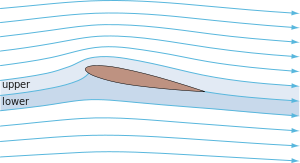
In fluid dynamics, potential flow or irrotational flow refers to a description of a fluid flow with no vorticity in it. Such a description typically arises in the limit of vanishing viscosity, i.e., for an inviscid fluid and with no vorticity present in the flow.
Potential flow describes the velocity field as the gradient of a scalar function: the velocity potential. As a result, a potential flow is characterized by an irrotational velocity field, which is a valid approximation for several applications. The irrotationality of a potential flow is due to the curl of the gradient of a scalar always being equal to zero.
In the case of an incompressible flow the velocity potential satisfies Laplace's equation, and potential theory is applicable. However, potential flows also have been used to describe compressible flows and Hele-Shaw flows. The potential flow approach occurs in the modeling of both stationary as well as nonstationary flows.
Applications of potential flow include: the outer flow field for aerofoils, water waves, electroosmotic flow, and groundwater flow. For flows (or parts thereof) with strong vorticity effects, the potential flow approximation is not applicable. In flow regions where vorticity is known to be important, such as wakes and boundary layers, potential flow theory is not able to provide reasonable predictions of the flow.[1] Fortunately, there are often large regions of a flow where the assumption of irrotationality is valid which is why potential flow is used for various applications. For instance in: flow around aircraft, groundwater flow, acoustics, water waves, and electroosmotic flow.[2]
- ^ Batchelor (1973) pp. 378–380.
- ^ Kirby, B.J. (2010), Micro- and Nanoscale Fluid Mechanics: Transport in Microfluidic Devices., Cambridge University Press, ISBN 978-0-521-11903-0